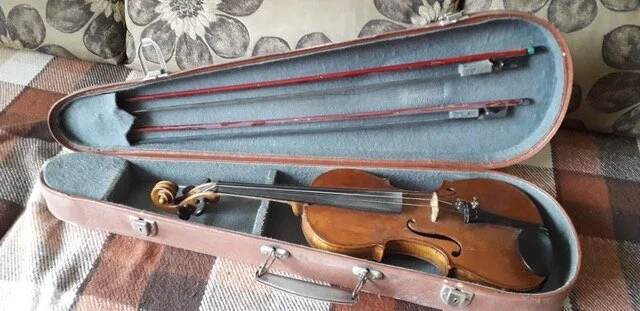The violin that survived
By Anna Romandash, in Novyi Rozdil (western Ukraine)
My violin is old. I cannot stress this enough. A violin does not have an expiration date if handled carefully, but mine does. Or at least it did. It has been nearly ten years since I touched it after leaving it all alone in its shabby case. I packed it carefully on my last day in art school and placed it in the back of my large closet. I always thought that eventually, I would start playing violin again even though I no longer had the need. Yet the moment never came. Until this summer.
When I felt myself trapped in the smallness of my apartment, the need for space started creeping in. My work is based in Barcelona, but I’m spending the summer in my home town in western Ukraine : Novyi Rozdil, a two hour drive from the Polish border. The things I did not need were supposed to go so I would have more room for myself and my newly-founded apartment existence. The violin, naturally, came to light. I discovered its sad appearance when looking through the closet, and my first thought was to sell it.
“It’s a good violin,” I thought. “Sure, it’s old, but that makes it all the more valuable.”
The violin, after all, was not mass-produced. It was crafted by a violin master, a talented guy making money on the side in Soviet Union. My grandmother bought it for my dad while forcing him to go to art school. It cost her around 1,000 Rubles, triple the price of a mass-produced violin. Decades later, it became my artefact although unlike my father, I chose to go to art school on my own. I carried the violin with me five days a week when I walked to my music classes. They took place outside of the tiny town where I lived, in a mountainous region of western Ukraine. Every day, I walked for thirty minutes to school, and then thirty minutes more to return. The most-Soviet town stood unchanged before me as I carried my instrument to learn new tunes.
The violin, a beautiful mix of golden and brown, was this delicate tool that connected strings, wood, and metal, and that produced stunning melodies when it wanted to. I liked holding it by the scroll, the decoratively carved top of the instrument, playing with my fingers on the fingerboard while observing how the strings trembled. It made me feel special knowing that I had it and could control it. For a while, I even thought I would become a professional musician, so the violin was preparing itself for a long and active life as my companion. After seven years of art school with me, the instrument could finally enter a truly musical world.
However, me going to a conservatory was just a fling, a flirtation. I quickly abandoned that idea, and after graduating from art school, I stopped playing often. And then, I stopped playing at all. The violin was neatly packed and spent a decade in its very heavy case surrounded by other things I did not have the heart to throw away or sell. The closet hosted it for ten years, and it was only because of my stay-at-home reality that I rediscovered the instrument.
Getting the violin out seemed strange at first. My fingers were rusty, and so was the instrument. We did not recognise each other, so it was hard to get the same beautiful sounds from this lonely friend I abandoned.
As I try to play now, the music is there. It is not the same feeling I had when I was a teenager, and my relationship with the violin is different now. I don’t play because I need to; it is my choice to touch this beautiful instrument, to greet it with some delicate moves, and to make it sing out of happiness or hopelessness.
The violin in question.
Photo / Anna Romandash

